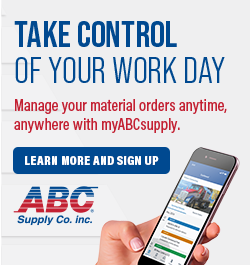Gaining Control of Your Own Roofing Materials

RCS Influencer Peter Horch says that warehousing your own materials can be helpful to rural roofing companies.
Editor's note: The following is a transcript of a conversation between our Multimedia Manager Megan Ellsworth and Horch Roofing Owner Peter Horch.
Megan Ellsworth: Hello, everyone. My name is Megan Ellsworth, here at RoofersCoffeeShop.com. And I'm with Peter Horch, influencer here at Roofers Coffee Shop. So, hi, Peter. How you doing?
Peter Horch: I'm so good. How are you?
Megan Ellsworth: Doing good. I'm glad to be with you right now, and excited to hear what you have to say about this month's topic, which is all about material coordination. And the question is, how are contractors balancing, just in time ordering with warehousing their own materials? And what is best practices for the changing economy?
Peter Horch: I love this question, but I also have to admit that I'm in a unique scenario or a unique situation. My company's located on the mid coast of Maine and in southern Maine, and this market is what we call rural. It is our closest large roofing distribution company is about an hour away from our locations, which isn't uncommon. But years ago, what I realized was having control of my own material and having control of my own deliveries was more important than depending on a distribution partner. And that being said, we have a great partnership with our distribution company, and they do everything they can to make sure that we have materials. But I also recognize that, because I'm in a rural area, land and building space is not as expensive as in other areas in the country. And so, what we have done is we actually take delivery of our material, and we warehouse it ourselves.
That goes from pallet to shingles to coils of metal to anything related to a roof project, from plywood to drip edge, ridge vent, pallets of nails. And the advantage of this is that we were able to negotiate lower prices, because we were taking bulk delivery to one location. And so, we could take a truckload of shingles at one location and then drop that off, and they're able to get to other customers. While, if I had that same truckload, it would be three or four locations all across the state of Maine. So I'm sorry, when COVID hit and there was a material shortage, we were actually in a really good position, because we had, not only a little bit of backlog of material already, but we also continued to have distribution be able to give us material, because we had warehouse space.
So for me, I'm still sold on the fact that it's a balancing act between two of those decisions. One is, don't have high overhead and don't have a lot of warehouse space, because it puts a burden on your business. But on the other hand, have the warehouse space, at least a little bit, so that you have backlog of material, in case anything goes wrong. And that's a real, like I said, a balancing act. But for me, because of where I'm located and because of the cost of real estate, I'm able to lean more towards relying on myself for distribution than for on-time delivery.
Megan Ellsworth: Wow, that's really interesting that you already had that implemented when COVID hit. So it was also the distributor was also used to doing that already, so that's really cool. Wow.
Peter Horch: Yeah, we didn't have to adjust much when COVID hit. We did ask for more material, like a lot of roofers did. And our offices are located between two locations, over five acres. And so, we were able to take truckloads of material and house them and warehouse them, so that we had enough to cover our workload.
Megan Ellsworth: Wow, that's really interesting. What would you say to a contractor that's looking to kind of start their own little warehouse for a backlog of materials? Any words of advice?
Peter Horch: Yeah. The way I did it ended up, even though it was my first try, the way I did it seemed to work really well, which is to start small and then, have room for growth. So if you're going to buy a warehouse or use a warehouse, start reasonable, so it doesn't put a big burden on your P&L and on your business. But then, have a capacity for expansion. So I had a three acre lot, and I started with just cutting or clearing some property and putting down a gravel pad. And that was my first step. And we were able to park more trucks and were able to warehouse some material, but then, it grew into a warehouse, like an actual shop. And then, that doubled in size in the future. But I always had enough land and space to do that. So if you're going to, depending on your needs right now, only do what you need now and maybe in the next couple years, and if it's successful, give yourself a little bit of room, if you can, for expansion in the future.
Megan Ellsworth: Wow. Well said. Well, thank you so much, Peter. Any last words on this topic?
Peter Horch: Nope.
Megan Ellsworth: Awesome. Well, very well said. And I think that's going to be really helpful for a lot of people, and that's just really interesting that you already had it all set up and ready to go. And look at you now.
Peter Horch: Yeah.
Megan Ellsworth: Awesome. Well, thank you so much, and we will chat next month on the next topic.
Peter Horch is the owner of Horch Roofing. See his full bio here.






















Comments
Leave a Reply
Have an account? Login to leave a comment!
Sign In